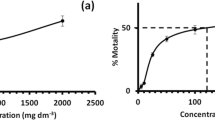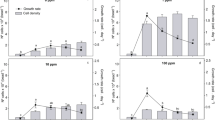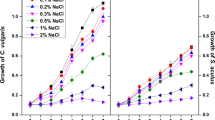Abstract
Carbamazepine (CBZ) has drawn extensive attention due to their environmental threats. In this study, polyvinyl alcohol-sodium alginate polymers to immobilize Chlorella vulgaris (FACHB-8) were used to investigate whether immobilization can facilitate microalgae to alleviate the CBZ stress and enhance CBZ removal. The results showed that after immobilized treatment, the biomass of microalgae increased by approximately 20%, the maximum level of malondialdehyde content decreased from 28 to 13 μmol/g, and the photosynthetic capacity of FV/FM recovered to 90% of the control group. The CBZ removal rate increased from 67 to 84% by immobilization at a CBZ concentration of 80 mg·L−1. The results indicated that immobilization technology can effectively protect microalgae from CBZ toxicity and improve the removal of CBZ, especially at high concentrations (> 50 mg/L). Biodegradation was the dominant pathway for microalgae to remove carbamazepine. This study added the understanding of the microalgae responses under immobilization and the interactions between immobilized microalgae and CBZ removal, thereby providing a novel insight into microalgae technology in high concentration wastewater treatments.
Graphical abstract







Similar content being viewed by others
Data availability
The datasets used and/or analyzed during the current study are available from the corresponding author on reasonable request.
References
Al Ketife AMD, Al Momani F, Judd S (2020) A bioassimilation and bioaccumulation model for the removal of heavy metals from wastewater using algae: New strategy. Process Saf Environ Prot 144:52–64. https://doi.org/10.1016/j.psep.2020.07.018
Almomani F (2020a) Algal cells harvesting using cost-effective magnetic nano-particles. Sci Total Environ 720:137621. https://doi.org/10.1016/j.scitotenv.2020.137621
Almomani F (2020b) Kinetic modeling of microalgae growth and CO2 bio-fixation using central composite design statistical approach. Sci Total Environ 720:137594. https://doi.org/10.1016/j.scitotenv.2020.137594
Almomani F, Bhosale RR (2021) Bio-sorption of toxic metals from industrial wastewater by algae strains Spirulina platensis and Chlorella vulgaris: application of isotherm, kinetic models and process optimization. Sci Total Environ 755:142654. https://doi.org/10.1016/j.scitotenv.2020.142654
Almomani FA (2019) Assessment and modeling of microalgae growth considering the effects OF CO2, nutrients, dissolved organic carbon and solar irradiation. J Environ Manag 247:738–748. https://doi.org/10.1016/j.jenvman.2019.06.085
Archer E, Petrie B, Kasprzyk-Hordern B, Wolfaardt GM (2017) The fate of pharmaceuticals and personal care products (PPCPs), endocrine disrupting contaminants (EDCs), metabolites and illicit drugs in a WWTW and environmental waters. Chemosphere 174:437–446. https://doi.org/10.1016/j.chemosphere.2017.01.101
Ashkan Z, Hemmati R, Homaei A, Dinari A, Jamlidoost M, Tashakor A (2021) Immobilization of enzymes on nanoinorganic support materials: an update. Int J Biol Macromol 168:708–721. https://doi.org/10.1016/j.ijbiomac.2020.11.127
Chai WS, Tan WG, Halimatul Munawaroh HS, Gupta VK, Ho S-H, Show PL (2021) Multifaceted roles of microalgae in the application of wastewater biotreatment: a review Environmental Pollution 269 https://doi.org/10.1016/j.envpol.2020.116236
Chan SS, Khoo KS, Chew KW, Ling TC, Show PL (2022) Recent advances biodegradation and biosorption of organic compounds from wastewater: microalgae-bacteria consortium - A review. Bioresour Technol 344:126159. https://doi.org/10.1016/j.biortech.2021.126159
Cheirsilp B, Torpee S (2012) Enhanced growth and lipid production of microalgae under mixotrophic culture condition: effect of light intensity, glucose concentration and fed-batch cultivation. Bioresour Technol 110:510–516. https://doi.org/10.1016/j.biortech.2012.01.125
Chong YA et al (2021) Occurrence of antibiotics in waters, removal by microalgae-based systems, and their toxicological effects: a review. Sci Total Environ 813. https://doi.org/10.1016/j.scitotenv.2021.151891
Ferrer-Polonio E, Fernandez-Navarro J, Iborra-Clar MI, Alcaina-Miranda MI, Mendoza-Roca JA (2020) Removal of pharmaceutical compounds commonly-found in wastewater through a hybrid biological and adsorption process. J Environ Manag 263:110368. https://doi.org/10.1016/j.jenvman.2020.110368
Garcia-Espinoza JD, Mijaylova-Nacheva P, Aviles-Flores M (2018) Electrochemical carbamazepine degradation: effect of the generated active chlorine, transformation pathways and toxicity. Chemosphere 192:142–151. https://doi.org/10.1016/j.chemosphere.2017.10.147
Gojkovic Z, Lindberg RH, Tysklind M, Funk C (2019) Northern green algae have the capacity to remove active pharmaceutical ingredients. Ecotoxicol Environ Saf 170:644–656. https://doi.org/10.1016/j.ecoenv.2018.12.032
Gonçalves AL, Pires JCM, Simões M (2017) A review on the use of microalgal consortia for wastewater treatment. Algal Res 24:403–415. https://doi.org/10.1016/j.algal.2016.11.008
Hena S, Gutierrez L, Croue JP (2021) Removal of pharmaceutical and personal care products (PPCPs) from wastewater using microalgae: a review. J Hazard Mater 403:124041. https://doi.org/10.1016/j.jhazmat.2020.124041
Jaiswal KK et al (2021) Graphitic bio-char and bio-oil synthesis via hydrothermal carbonization-co-liquefaction of microalgae biomass (oiled/de-oiled) and multiple heavy metals remediations. J Hazard Mater 409:124987. https://doi.org/10.1016/j.jhazmat.2020.124987
Jarvis AL, Bernot MJ, Bernot RJ (2014) The effects of the psychiatric drug carbamazepine on freshwater invertebrate communities and ecosystem dynamics. Sci Total Environ 496:461–470. https://doi.org/10.1016/j.scitotenv.2014.07.084
Jin M et al (2019) Physiological responses of Chlorella pyrenoidosa to 1-hexyl-3-methyl chloride ionic liquids with different cations. Sci Total Environ 685:315–323. https://doi.org/10.1016/j.scitotenv.2019.05.303
Kabra AN, Ji MK, Choi J, Kim JR, Govindwar SP, Jeon BH (2014) Toxicity of atrazine and its bioaccumulation and biodegradation in a green microalga, Chlamydomonas mexicana. Environ Sci Pollut Res Int 21:12270–12278. https://doi.org/10.1007/s11356-014-3157-4
Karim A, Islam MA, Khalid ZB, Yousuf A, Khan MMR, Mohammad Faizal CK (2021) Microbial lipid accumulation through bioremediation of palm oil mill effluent using a yeast-bacteria co-culture. Renew Energy 176:106–114. https://doi.org/10.1016/j.renene.2021.05.055
Kurade MB, Kim JR, Govindwar SP, Jeon B-H (2016) Insights into microalgae mediated biodegradation of diazinon by Chlorella vulgaris : microalgal tolerance to xenobiotic pollutants and metabolism. Algal Res 20:126–134. https://doi.org/10.1016/j.algal.2016.10.003
Kusmayadi A, Leong YK, Yen HW, Huang CY, Chang JS (2021) Microalgae as sustainable food and feed sources for animals and humans - biotechnological and environmental aspects. Chemosphere 271:129800. https://doi.org/10.1016/j.chemosphere.2021.129800
Leng L et al (2020) Use of microalgae based technology for the removal of antibiotics from wastewater: a review. Chemosphere 238:124680. https://doi.org/10.1016/j.chemosphere.2019.124680
Li X, Li W, Zhai J, Wei H (2018) Effect of nitrogen limitation on biochemical composition and photosynthetic performance for fed-batch mixotrophic cultivation of microalga Spirulina platensis. Bioresour Technol 263:555–561. https://doi.org/10.1016/j.biortech.2018.05.046
Li X, Li W, Zhai J, Wei H, Wang Q (2019) Effect of ammonium nitrogen on microalgal growth, biochemical composition and photosynthetic performance in mixotrophic cultivation. Bioresour Technol 273:368–376. https://doi.org/10.1016/j.biortech.2018.11.042
Liu Y, Li N, Lou Y, Liu Y, Zhao X, Wang G (2020) Effect of water accommodated fractions of fuel oil on fixed carbon and nitrogen by microalgae: implication by stable isotope analysis. Ecotoxicol Environ Saf 195:110488. https://doi.org/10.1016/j.ecoenv.2020.110488
Marangon BB, Calijuri ML, Castro JS, Assemany PP (2021) A life cycle assessment of energy recovery using briquette from wastewater grown microalgae biomass. J Environ Manag 285:112171. https://doi.org/10.1016/j.jenvman.2021.112171
Meng Y, Liu W, Liu X, Zhang J, Peng M, Zhang T (2021) A review on analytical methods for pharmaceutical and personal care products and their transformation products. J Environ Sci (China) 101:260–281. https://doi.org/10.1016/j.jes.2020.08.025
Mojiri A, Baharlooeian M, Kazeroon RA, Farraji H, Lou Z (2020) Removal of pharmaceutical micropollutants with integrated biochar and marine microalgae microorganisms 9 https://doi.org/10.3390/microorganisms9010004
Mujtaba G, Lee K (2017) Treatment of real wastewater using co-culture of immobilized Chlorella vulgaris and suspended activated sludge. Water Res 120:174–184. https://doi.org/10.1016/j.watres.2017.04.078
Nagappan S, Tsai PC, Devendran S, Alagarsamy V, Ponnusamy VK (2020) Enhancement of biofuel production by microalgae using cement flue gas as substrate. Environ Sci Pollut Res Int 27:17571–17586. https://doi.org/10.1007/s11356-019-06425-y
Noguchi M et al. (2021) Application of real treated wastewater to starch production by microalgae: potential effect of nutrients and microbial contamination Biochem Eng J 169 https://doi.org/10.1016/j.bej.2021.107973
Pan M, Lyu T, Zhan L, Matamoros V, Angelidaki I, Cooper M, Pan G (2021) Mitigating antibiotic pollution using cyanobacteria: removal efficiency, pathways and metabolism. Water Res 190:116735. https://doi.org/10.1016/j.watres.2020.116735
Papazi A, Karamanli M, Kotzabasis K (2019) Comparative biodegradation of all chlorinated phenols by the microalga Scenedesmus obliquus - the biodegradation strategy of microalgae. J Biotechnol 296:61–68. https://doi.org/10.1016/j.jbiotec.2019.03.010
Park C et al (2016) Eco-design and evaluation for production of 7-aminocephalosporanic acid from carbohydrate wastes discharged after microalgae-based biodiesel production. J Clean Prod 133:511–517. https://doi.org/10.1016/j.jclepro.2016.05.168
Peter AP, Khoo KS, Chew KW, Ling TC, Ho S-H, Chang J-S, Show PL (2021) Microalgae for biofuels, wastewater treatment and environmental monitoring. Environ Chem Lett 19:2891–2904. https://doi.org/10.1007/s10311-021-01219-6
Qiao X, Sun G, Clare JJ, Werkman TR, Wadman WJ (2014) Properties of human brain sodium channel alpha-subunits expressed in HEK293 cells and their modulation by carbamazepine, phenytoin and lamotrigine. Br J Pharmacol 171:1054–1067. https://doi.org/10.1111/bph.12534
Qin L et al (2016) Microalgae consortia cultivation in dairy wastewater to improve the potential of nutrient removal and biodiesel feedstock production. Environ Sci Pollut Res Int 23:8379–8387. https://doi.org/10.1007/s11356-015-6004-3
Quinn JC, Davis R (2015) The potentials and challenges of algae based biofuels: a review of the techno-economic, life cycle, and resource assessment modeling. Bioresour Technol 184:444–452. https://doi.org/10.1016/j.biortech.2014.10.075
Sharif F, Westerhoff P, Herckes P (2014) Impact of hydraulic and carbon loading rates of constructed wetlands on contaminants of emerging concern (CECs) removal. Environ Pollut 185:107–115. https://doi.org/10.1016/j.envpol.2013.10.001
Silambarasan S, Logeswari P, Sivaramakrishnan R, Incharoensakdi A, Cornejo P, Kamaraj B, Chi NTL (2021) Removal of nutrients from domestic wastewater by microalgae coupled to lipid augmentation for biodiesel production and influence of deoiled algal biomass as biofertilizer for Solanum lycopersicum cultivation. Chemosphere 268:129323. https://doi.org/10.1016/j.chemosphere.2020.129323
Song C, Wei Y, Qiu Y, Qi Y, Li Y, Kitamura Y (2019) Biodegradability and mechanism of florfenicol via Chlorella sp. UTEX1602 and L38: experimental study. Bioresour Technol 272:529–534. https://doi.org/10.1016/j.biortech.2018.10.080
Song C, Wei Y, Sun J, Song Y, Li S, Kitamura Y (2020) Biodegradation and metabolic fate of thiamphenicol via Chlorella sp. UTEX1602 and L38 Bioresour Technol 296:122320 https://doi.org/10.1016/j.biortech.2019.122320
Sun J, Cheng J, Yang Z, Zhou J (2020) Heavy metal control in microalgae cultivation with power plant flue gas entering into raceway pond. Environ Sci Pollut Res Int 27:37357–37362. https://doi.org/10.1007/s11356-020-08220-6
Tang DYY, Khoo KS, Chew KW, Tao Y, Ho SH, Show PL (2020) Potential utilization of bioproducts from microalgae for the quality enhancement of natural products. Bioresour Technol 304:122997. https://doi.org/10.1016/j.biortech.2020.122997
Villota N, Ferreiro C, Qulatein HA, Lomas JM, Camarero LM, Lombraña JI (2021) Colour changes during the carbamazepine oxidation by photo-fenton catalysts 11 https://doi.org/10.3390/catal11030386
Vo HNP et al (2019a) Identification of the pollutants' removal and mechanism by microalgae in saline wastewater. Bioresour Technol 275:44–52. https://doi.org/10.1016/j.biortech.2018.12.026
Vo HNP et al (2019b) A critical review on designs and applications of microalgae-based photobioreactors for pollutants treatment. Sci Total Environ 651:1549–1568. https://doi.org/10.1016/j.scitotenv.2018.09.282
Wang H et al (2020a) Photosynthetic toxicity of non-steroidal anti-inflammatory drugs (NSAIDs) on green algae Scenedesmus obliquus. Sci Total Environ 707:136176. https://doi.org/10.1016/j.scitotenv.2019.136176
Wang Q, Liu W, Li X, Wang R, Zhai J (2020b) Carbamazepine toxicity and its co-metabolic removal by the cyanobacteria Spirulina platensis. Sci Total Environ 706:135686. https://doi.org/10.1016/j.scitotenv.2019.135686
Wang S, Ji B, Zhang M, Ma Y, Gu J, Liu Y (2020c) Defensive responses of microalgal-bacterial granules to tetracycline in municipal wastewater treatment. Bioresour Technol 312. https://doi.org/10.1016/j.biortech.2020.123605
Wu J-Y, Lay C-H, Chia SR, Chew KW, Show PL, Hsieh P-H, Chen C-C (2021) Economic potential of bioremediation using immobilized microalgae-based microbial fuel cells. Clean Techn Environ Policy 23:2251–2264. https://doi.org/10.1007/s10098-021-02131-x
Xiao G et al (2021) Evaluating the application of antibiotic treatment using algae-algae/activated sludge system. Chemosphere 282:130966. https://doi.org/10.1016/j.chemosphere.2021.130966
Yao M, Duan L, Wei J, Qian F, Hermanowicz SW (2020) Carbamazepine removal from wastewater and the degradation mechanism in a submerged forward osmotic membrane bioreactor. Bioresour Technol 314:123732. https://doi.org/10.1016/j.biortech.2020.123732
Zaied BK, Rashid M, Nasrullah M, Zularisam AW, Pant D, Singh L (2020) A comprehensive review on contaminants removal from pharmaceutical wastewater by electrocoagulation process. Sci Total Environ 726:138095. https://doi.org/10.1016/j.scitotenv.2020.138095
Zandalinas SI, Mittler R (2018) ROS-induced ROS release in plant and animal cells. Free Radic Biol Med 122:21–27. https://doi.org/10.1016/j.freeradbiomed.2017.11.028
Zhang C, Chen X, Tan L, Wang J (2018) Combined toxicities of copper nanoparticles with carbon nanotubes on marine microalgae Skeletonema costatum. Environ Sci Pollut Res Int 25:13127–13133. https://doi.org/10.1007/s11356-018-1580-7
Zhang W, Zhao C, Cao W, Sun S, Hu C, Liu J, Zhao Y (2020) Removal of pollutants from biogas slurry and CO2 capture in biogas by microalgae-based technology: a systematic review. Environ Sci Pollut Res Int 27:28749–28767. https://doi.org/10.1007/s11356-020-09282-2
Zhang X, Li B, Xu H, Wells M, Tefsen B, Qin B (2019) Effect of micronutrients on algae in different regions of Taihu, a large, spatially diverse, hypereutrophic lake. Water Res 151:500–514. https://doi.org/10.1016/j.watres.2018.12.023
Zhong X, Zhu Y, Wang Y, Zhao Q, Huang H (2021) Effects of three antibiotics on growth and antioxidant response of Chlorella pyrenoidosa and Anabaena cylindrica. Ecotoxicol Environ Saf 211:111954. https://doi.org/10.1016/j.ecoenv.2021.111954
Zhu L et al (2020) Ecotoxicological effects of sulfonamide on and its removal by the submerged plant Vallisneria natans (Lour.) Hara. Water Res 170:115354. https://doi.org/10.1016/j.watres.2019.115354
Zhuang L-L, Li M, Hao Ngo H (2020) Non-suspended microalgae cultivation for wastewater refinery and biomass production. Bioresour Technol:308. https://doi.org/10.1016/j.biortech.2020.123320
Funding
This research was funded by the National Natural Science Foundation of China (U2040209 and 51739002), the Fundamental Research Funds for Central Universities (B200202110), and the Excellent Scientific and Technological Innovation Team in Jiangsu Province.
Author information
Authors and Affiliations
Contributions
All authors contributed to the study conception and design. Material preparation, data collection, and analysis were performed by Zulin Hua, Xue Bai, and Lu Liang. The first draft of the manuscript was written by Lu Liang and all authors commented on previous versions of the manuscript. All authors read and approved the final manuscript.
Corresponding author
Ethics declarations
Ethics approval and consent to participate
Not applicable.
Consent for publication
Not applicable.
Competing interests
The authors declare no competing interests.
Additional information
Responsible Editor: Gangrong Shi
Publisher’s note
Springer Nature remains neutral with regard to jurisdictional claims in published maps and institutional affiliations.
Highlights
• Immobilization improved 6 to 17% of carbamazepine removal by C. vulgaris.
•·Immobilization reduced oxidative stress and repaired photosynthesis in C. vulgaris.
•·The protective effect of immobilization was more apparent at high CBZ stress.
•·Biodegradation accounted for more than 80% of the total removal rate of carbamazepine.
•·Immobilization improves the proportion of biodegradation in the CBZ removal pathway.
Rights and permissions
About this article
Cite this article
Liang, L., Bai, X. & Hua, Z. Enhancement of the immobilization on microalgae protective effects and carbamazepine removal by Chlorella vulgaris. Environ Sci Pollut Res 29, 79567–79578 (2022). https://doi.org/10.1007/s11356-022-21418-0
Received:
Accepted:
Published:
Issue Date:
DOI: https://doi.org/10.1007/s11356-022-21418-0




